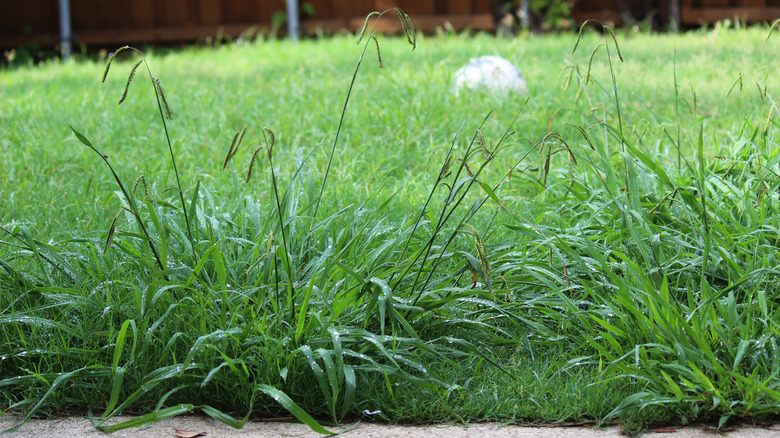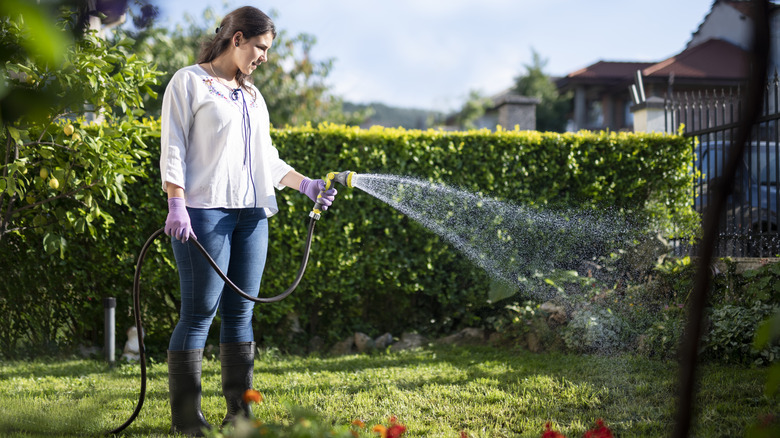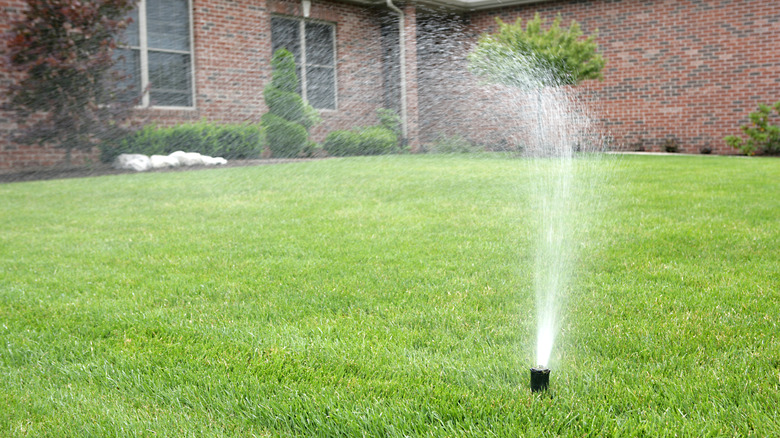The Watering Mistake That's Encouraging Crabgrass To Grow In Your Yard
Crabgrass is a summer annual that most homeowners dread. It's an unsightly grass that grows fast and disperses seeds just as quickly. If allowed, crabgrass will compete with other turf for soil, light, and nutrients. Though it may seem like its presence is inevitable, you can take precautions to limit its growth. In fact, by avoiding a simple watering mistake, you can drastically reduce the likelihood of a crabgrass infestation. The next time you water your turf, take enough time to water it deeply, and you'll be closer to having a flourishing green lawn. Otherwise, crabgrass is more likely to creep in, thriving in stressed and under-watered lawns.
Strong roots are the key to any healthy plant; the grass of your lawn is no exception. The root systems beneath the soil are vital to the overall quality of a lawn. Properly watering your lawn will allow your grass roots to better penetrate the soil. A deeper, more established root system is stronger than any new roots crabgrass will grow. So rather than crabgrass out-competing your turf, your turf will muscle out the competition.
Strengthen your lawn with deep watering
A reliable watering schedule with adequate watering time is essential for a strong root system. The trick isn't to water more frequently but rather to water more thoroughly. Most irrigation clocks are set for a twenty-minute session. However, that's not enough time for water to really penetrate the soil and absorb into the roots below. Short and frequent waterings contribute to shallow roots that stay near the surface. When near the surface, roots are less protected from pests and diseases, which will severely stunt a lawn's soil health.
Instead, establish an infrequent watering schedule that is focused on giving the lawn enough hydration. It's best to water your grass in the morning so that there's enough time for the water to penetrate the soil before higher temperatures cause the water to evaporate. Soak your grass so that the water permeates the soil to a depth between 6 and 8 inches. This may require you to water, wait, and water again to allow the water enough time to absorb into the soil. Do your best to ensure your lawn gets about 1 to 1½ inches of water per week in total.
How to know if you're watering your lawn enough
Once you know the ideal way to water your lawn, you'll likely wonder if you're actually watering your lawn enough. Crabgrass is not always the best indicator of inadequate water. It's possible to have no crabgrass and still find your lawn isn't growing as it should. You might observe wilting or drought stress. Wilting occurs when the cells in a plant collapse due to lack of water. Your grass should stand up straight when properly hydrated. While some larger plants may droop due to weight, your lawn will never have that particular problem. If you're seeing wilting blades of grass, you're most likely not watering it thoroughly. Remember, it's not so much about the number of times you water but the duration of the watering. A shift in color is also an indicator that your turf is beginning to wilt. Be on the lookout for bluish-green color changes.
Brittle brown or gray grass, visible footprints, and dry soil are all indicators of drought stress. Ideally, your lawn will be soft, green, and springy when you walk over it. Blades that do not bounce back after activity are not hydrated enough. Weak grass typically suggests weak roots, too. So, if you're seeing wilting, drought stress, or crabgrass, consider a change to your watering schedule. Watering less frequently for a longer period is the best solution for a healthy, green lawn.


